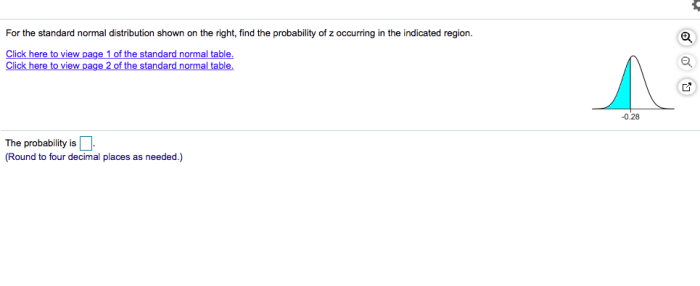Find the probability of z occurring in the indicated region – Delving into the realm of probability theory, we embark on an exploration of finding the probability of Z occurring within a specified region. This concept holds immense significance in statistical analysis and forms the cornerstone of various real-world applications.
By transforming a random variable into a standard normal variable (Z-score), we unlock the power to calculate the likelihood of Z falling within a given interval. This transformation allows us to leverage the well-defined properties of the standard normal distribution, providing a standardized framework for probability calculations.
Probability Theory

Probability theory is the branch of mathematics that deals with the likelihood of events occurring. It provides a framework for quantifying the uncertainty associated with random events and making predictions about future outcomes.
Key concepts in probability theory include:
- Sample space: The set of all possible outcomes of an experiment.
- Event: A subset of the sample space.
- Probability: A numerical measure of the likelihood of an event occurring.
Standard Normal Distribution

The standard normal distribution, also known as the Gaussian distribution or bell curve, is a continuous probability distribution that is defined by two parameters: mean (μ) and standard deviation (σ).
The probability density function (PDF) of the standard normal distribution is given by:
f(z) = (1 / √(2π))
e^(-z^2 / 2)
where z is the standardized value of a random variable X, defined as:
z = (X
μ) / σ
The cumulative distribution function (CDF) of the standard normal distribution is given by:
F(z) = P(X ≤ z) = (1 / √(2π))
∫z-∞e^(-t^2 / 2) dt
Finding Probabilities for Z

To find the probability of Z occurring in a given region, we use the CDF of the standard normal distribution. The probability of Z being between z 1and z 2is given by:
P(z1≤ Z ≤ z 2) = F(z 2)
F(z1)
Applications

Finding probabilities for Z has numerous applications in real-world scenarios, including:
- Hypothesis testing: Determining the likelihood of obtaining a sample result if the null hypothesis is true.
- Confidence intervals: Estimating the range within which a population parameter is likely to fall.
- Quality control: Assessing the probability of a product meeting certain specifications.
- Financial modeling: Predicting the likelihood of financial events, such as stock prices or bond yields.
Quick FAQs: Find The Probability Of Z Occurring In The Indicated Region
What is the significance of finding probabilities for Z?
Finding probabilities for Z allows us to quantify the likelihood of events occurring within a specified range, providing a basis for statistical inference and decision-making.
How do we transform a random variable into a standard normal variable?
To transform a random variable into a standard normal variable, we subtract the mean and divide by the standard deviation, resulting in a Z-score that follows the standard normal distribution.